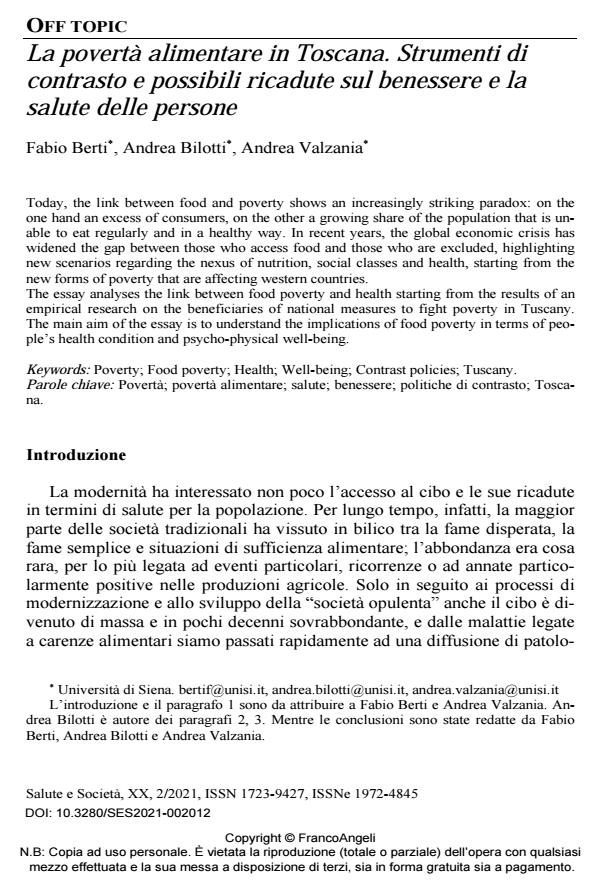La povertà alimentare in Toscana. Strumenti di contrasto e possibili ricadute sul benessere e la salute delle persone
Journal title SALUTE E SOCIETÀ
Author/s Fabio Berti, Andrea Bilotti, Andrea Valzania
Publishing Year 2021 Issue 2021/2
Language Italian Pages 15 P. 169-183 File size 218 KB
DOI 10.3280/SES2021-002012
DOI is like a bar code for intellectual property: to have more infomation
click here
Below, you can see the article first page
If you want to buy this article in PDF format, you can do it, following the instructions to buy download credits

FrancoAngeli is member of Publishers International Linking Association, Inc (PILA), a not-for-profit association which run the CrossRef service enabling links to and from online scholarly content.
Today, the link between food and poverty shows an increasingly striking paradox: on the one hand an excess of consumers, on the other a growing share of the population that is unable to eat regularly and in a healthy way. In recent years, the global economic crisis has widened the gap between those who access food and those who are excluded, highlighting new scenarios regarding the nexus of nutrition, social classes and health, starting from the new forms of pov-erty that are affecting western countries. The essay analyses the link between food poverty and health starting from the results of an empirical research on the beneficiaries of national measures to fight poverty in Tuscany. The main aim of the essay is to understand the implications of food poverty in terms of people’s health condition and psycho-physical well-being.
Keywords: Poverty; Food poverty; Health; Well-being; Contrast policies; Tuscany.
- Povertà alimentare, right to food e politiche locali del cibo. Prime riflessioni critiche Alessia Toldo, Veronica Allegretti, Sabrina Arcuri, Maurizia Pierri, in RIVISTA GEOGRAFICA ITALIANA 4/2023 pp.133
DOI: 10.3280/rgioa4-2023oa16855 - The Palgrave Handbook of Practical Sustainability Michele Filippo Fontefrancesco, pp.541 (ISBN:978-3-031-82856-0)
- Less state and more solidarity shops: the Italian method to combat food poverty Fabio Berti, Andrea Valzania, in Frontiers in Sustainable Food Systems 1596425/2025
DOI: 10.3389/fsufs.2025.1596425
Fabio Berti, Andrea Bilotti, Andrea Valzania, La povertà alimentare in Toscana. Strumenti di contrasto e possibili ricadute sul benessere e la salute delle persone in "SALUTE E SOCIETÀ" 2/2021, pp 169-183, DOI: 10.3280/SES2021-002012